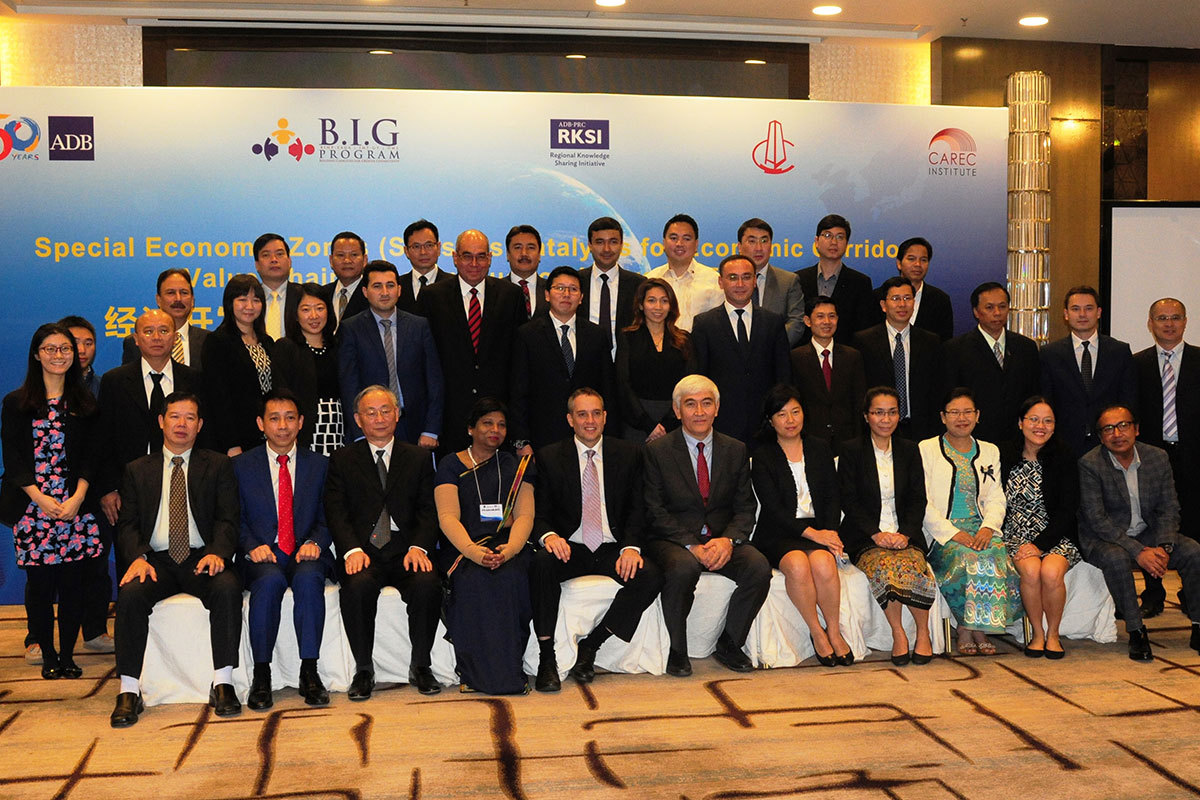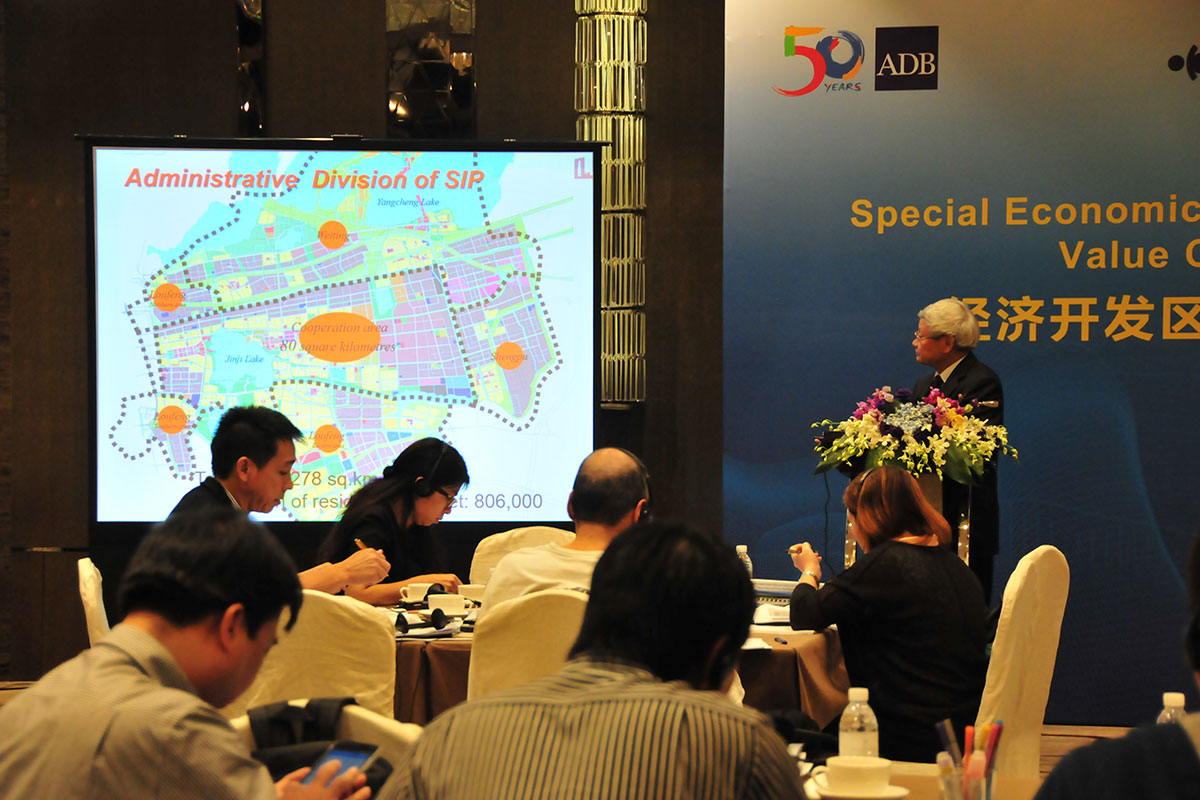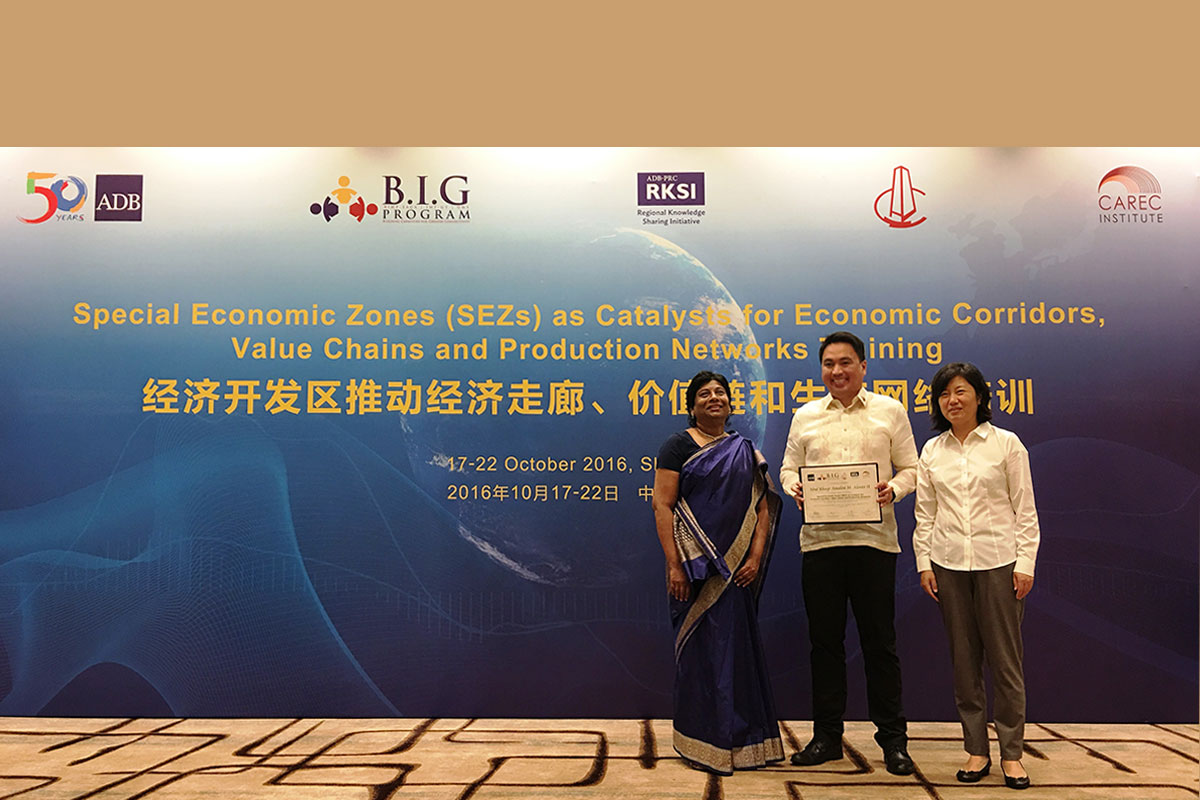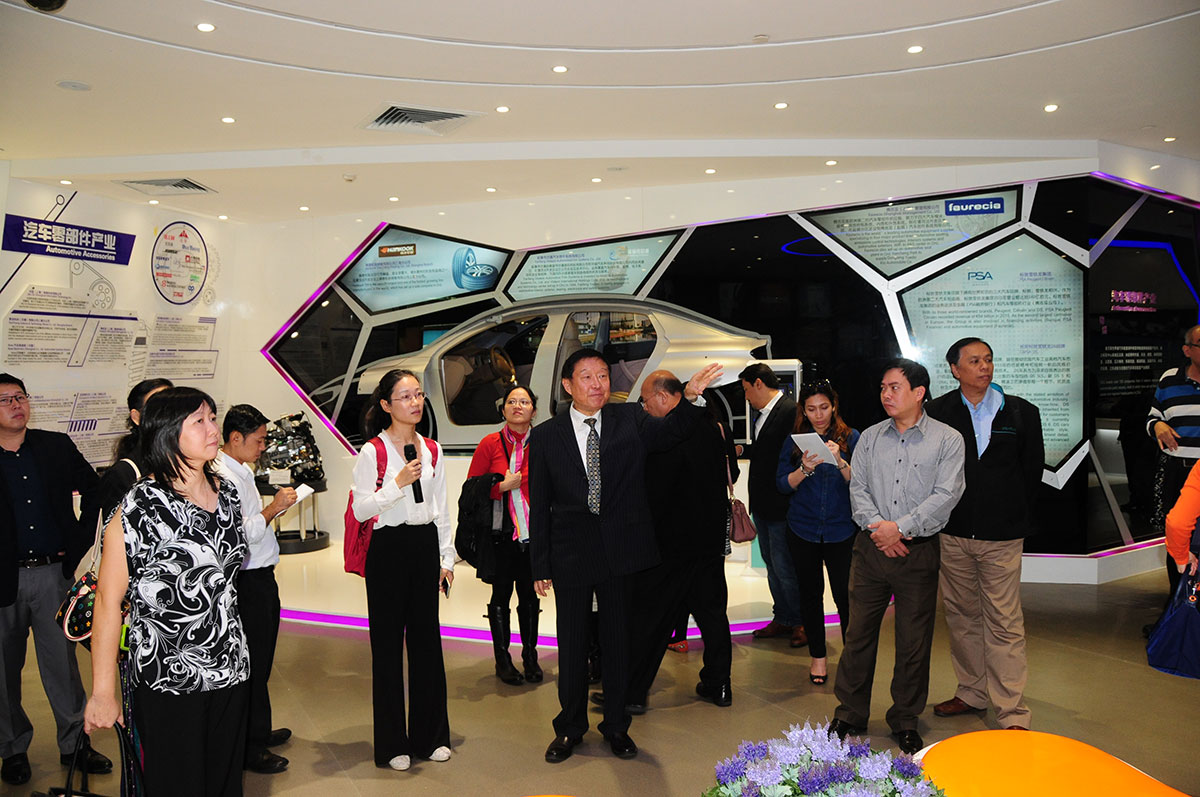Workshop & Training
Special Economic Zones (SEZs) As Catalysts for Economic Corridors, Value Chains and Production Networks 2016
17 Oct 2016 - 22 Oct 2016 Shanghai, The People's Republic of China



About 30 Central Asian, Brunei Darussalam-Indonesia-Malaysia-the Philippines East ASEAN Growth Area (BIMP-EAGA), Indonesia-Malaysia-Thailand Growth Triangle (IMT-GT), and Greater Mekong Sub-region (GMS) officials participated in the training organized by the ADB Southeast Department, ADB-PRC Regional Knowledge Sharing Initiative, Central Asia Regional Economic Cooperation (CAREC) Institute, and China Association of Development Zones on 17-22 October in Shanghai. The training covered concepts and cases in SEZ design, management, and evaluation in Asia, and highlighted the PRC’s experience.
Agenda:
Module 1: Development Context and SEZs Design, Implementation and Management
| Time | Program |
|---|---|
| 0800 – 0830 | Registration Pre-test Administrative Announcements |
| 0830 – 0900 | Opening Ceremonies Welcome Remarks and Messages Group Photo |
| 0900 – 1015 | Session 1.1 Introduction and Training Roadmap Interactive Exercise: Getting to Know You, Expectations Check and Training Overview and Objectives Ms. Pamela Asis-Layugan, Team Leader and Training Specialist (Consultant) and Ms. Jordana Queddeng, Program Analyst (Consultant), ADB-RCDTA 8836 Interactive session for participants to get to know each other, develop learning contract and discuss the training overview and objectives. |
| 1015 – 1030 | Tea/Coffee Break |
| 1030 – 1200 | Session 1.2 Lecture and Discussions: Rationale and Role of Special Economic Zones (SEZs) in Economic Development Dr. Aradhna Aggarwal, Chair Professor, Department of International Business and Economics, Copenhagen Business School The session will present SEZs concepts, types, evolution, rationale, role in economic development, benefits, linkages with development strategies and future trends. |
| 1200 – 1330 | Lunch Break |
| 1330 – 1500 | Session 1.3 Lecture and Discussions: Design, Implementation and Management of Effective SEZs Dr. Aradhna Aggarwal, Chair Professor, Department of International Business and Economics, Copenhagen Business School The session will introduce factors that lead to effective design, implementation and management of SEZs which can include land use and spatial planning, infrastructure and support services, institutional design and approaches, investment promotion, business development services, labor market development, and monitoring and evaluation. |
| 1500 – 1515 | Tea/Coffee Break |
| 1515 – 1630 | Session 1.4 Workshop and Exercise: SEZs as Development Approaches in BIMP-EAGA, IMT-GT, GMS and CAREC Pamela Asis-Layugan, Team Leader & Training Specialist (Consultant), ADB RCDTA 8836 and Participants in Multi-country teams Participants organized in teams (BIMP-EAGA, IMT-GT, GMS and CAREC) to assess and present the subregional cooperation programs (SCPs): (i) SEZs development approaches (e.g. as part of economic corridors); (ii) experiences, success stories and lessons in SEZs; (iii) challenges and bottlenecks in SEZs design, implementation and management; and (iv) recommendations at national and subregional levels. Guide questions and template to be provided |
| 1630 – 1730 | Session 1.5 Plenary Presentations: SEZs as Development Approaches in BIMP-EAGA, IMT-GT, GMS and CAREC Alfredo Perdiguero, Principal Regional Cooperation Specialist, ADB, Pamela Asis-Layugan, Team Leader & Training Specialist (Consultant), ADB RCDTA 8836 and Participants in Multi-country teams Participants present workshop outputs. |
| 1830 – 2000 | Welcome Dinner hosted by ADB at the Shanghai Oriental Pearl Tower |
Module 1: Development Context and SEZs Design, Implementation and Management
Module 2: Measuring Impact and Performance of SEZs
| Time | Program |
|---|---|
| 0845 – 1015 | Session 2.1 Presentation and Discussion: Implementation Strategies and Designs of SEZs: A Comparative Analysis of SEZ Dr. Aradhna Aggarwal, Chair Professor, Department of International Business and Economics, Copenhagen Business School The session will present different practices regarding the types of SEZs developed and their relevance in the overall context taken by countries in various subregions in Asia (e.g. Southeast Asia, East Asia, Central Asia and South Asia). Good practices, pitfalls to be avoided and drawing common lessons will be highlighted. National and subregional implications and SEZs as tools in regional cooperation and integration will be emphasized. |
| 1015 – 1030 | Tea/Coffee Break |
| 1030 – 1200 | Session 2.2 Lecture and Discussions: Measuring SEZs Outcomes, Economic Impact and Performance in Asia and Other Continents Dr. Aradhna Aggarwal, Chair Professor, Department of International Business and Economics, Copenhagen Business School The session will present SEZ performance in Asia and other continents and will include tools, evaluation of performance and success drivers. |
| 1200 – 1330 | Lunch |
| 1330 – 1430 | Session 2.3 Presentation and Discussion: Special Border Economic Zone (SBEZ): Concepts, Characteristics and Applications Alfredo Perdiguero, Principal Regional Cooperation Specialist, ADB The session will present concepts, characteristics, and models of special border economic zones (SBEZs). A conceptual model for SBEZ development in IMT-GT (Thai-Malaysia border crossings) to include rationale, criteria in establishing SBEZs to be presented given the study is part of a broader project that intends to support SBEZ development. This is expected to help attract investors in productive activities that promote subregional value chains in order to stimulate cross-border trade and investment, serve as a catalyst to promote commerce along the IMT-GT corridors and help improve social and economic welfare of the population along the border provinces. |
| 1430 – 1530 | Session 2.4 Workshop and Exercise (Part 1): Select SEZs Country Case Studies in BIMP-EAGA, IMT-GT, GMS and CAREC Pamela Asis-Layugan, Team Leader & Training Specialist (Consultant), ADB RCDTA 8836 and Participants in Multi-country teams Participants organized in teams (BIMP-EAGA, IMT-GT, GMS and CAREC) to select one country in the subregion and assess SEZs (in particular country) in terms of: (i) links to development strategies; (ii) type of SEZs; (iii) success factors; (iv) performance drivers; (v) Institutional design and approaches; (vi) measuring outcome, performance and impact; and (vii) subregional implications. Guide questions and template to be provided |
| 1530 – 1545 | Tea/Coffee Break |
| 1545 – 1700 | Session 2.5 Plenary Presentations: Select SEZs Country Case Studies in BIMP-EAGA, IMT-GT, GMS and CAREC Alfredo Perdiguero, Principal Regional Cooperation Specialist ADB, Pamela Asis-Layugan, Team Leader & Training Specialist (Consultant), ADB RCDTA 8836 and Participants in Multi-country teams Participants organized in teams (BIMP-EAGA, IMT-GT, GMS and CAREC) to present workshop outputs |
| 1700 onwards | Free time |
Module 3: The PRC’s Experience in Developing Economic Zones
Module 3: The PRC’s Experience in Developing Economic Zones
Module 4: SEZs as Catalyst for Economic Corridors and Platforms for Value Chains and Production Networks
Module 4: SEZs as Catalyst for Economic Corridors and Platforms for Value Chains and Production Networks
Module 4: SEZs as Catalyst for Economic Corridors and Platforms for Value Chains and Production Networks
| Time | Program |
|---|---|
| 0900 – 0930 | Post Test |
| 0930 – 1015 | Session 4.7 Integration Exercise: Framework and Action Agenda for SEZs Development and Cooperation in BIMP-EAGA, IMT-GT, GMS and CAREC Participants in Multi-country teams Participants organized in teams (BIMP-EAGA, IMT-GT, GMS and CAREC) work on integration exercise |
| 1015 – 1030 | Tea/Coffee Break |
| 1030 – 1200 | Session 4.8 Integration Exercise: Framework and Action Agenda for SEZs Development and Cooperation in BIMP-EAGA, IMT-GT, GMS and CAREC Participants in Multi-country teams |
| 1200 – 1330 | Lunch |
| 1330 – 1500 | Session 4.9 Plenary Presentations (Part 1): Framework and Action Agenda for SEZs Development and Cooperation in BIMP-EAGA, IMT-GT, GMS and CAREC Participants to present exercise outputs and experts to provide comments/guidance |
| 1500 – 1515 | Tea/Coffee Break |
| 1515 – 1630 | Session 4.10 Plenary Presentations (Part 1): Framework and Action Agenda for SEZs Development and Cooperation in BIMP-EAGA, IMT-GT, GMS and CAREC Participants to present exercise outputs and experts to provide comments/guidance |
| 1630 – 1730 | Synthesis and Moving Forward Closing Ceremonies (Awarding of Certificates, Remarks and Messages) Group Photo |
| 1800 onwards | Closing Dinner hosted by ADB at Yu Garden |


